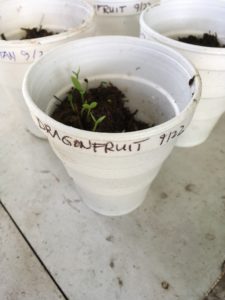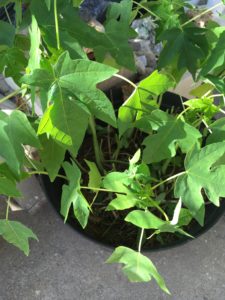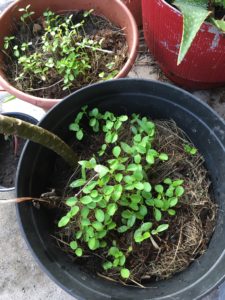


Actually, edible gardening has been on the upswing for years, and its growing popularity has been making the mainstream media for quite some time. It’s gotten extensive coverage by the New York Times among other major publications.
But this wonderful article by Ken Wells in the Wall Street Journal, “The New American Garden Is Edible,” particularly strikes my fancy because it introduces the general public to a specific kind of edible garden known as a “food forest,” which is a layered landscape of trees, shrubs, vines, and veggie plants. Mimicking the layered structure of a naturally occurring forest, a food forest of edible and/or native plants provides food for humans, as well as forage for pollinators and other beneficial species.
A food forest, once established, is much less labor-intensive and more resilient than a conventional vegetable garden where the veggies are cultivated in rows in bare soil. In a food forest, use of vertical space is maximized, and the plants shelter each other and share nutrients and other resources.
Edible gardening addresses multiple needs at once: One, it conserves water (according to some estimates, edible gardens use up to 66% less water than lawns — for more about that, see my “Further Reading” section at the end of this post). It also builds the soil, reduces erosion, builds drought-resilience, and boosts local food self-reliance. It brings neighbors together, and it gives families a productive and enjoyable activity to share.
Besides these benefits of edible gardening in general, food forests have the additional benefits of providing shade, habitat, and privacy. A food forest can even reduce your energy bill and make your home more comfortable, by mitigating temperature extremes.
Obtaining multiple yields in this manner is the hallmark of good design. The old saying is “killing two birds with one stone,” but I prefer to say “feeding two birds with one scone“! In permaculture design, we call it “stacking functions.” And the minute you start dedicating yourself to this approach (not just in your yard but in any other areas of your life), you will start saving lots of money, and have more time and energy for the things that really matter to you.
My photos for you today bring good news. The seeds I planted from a dragonfruit I ate the other day (thanks Ro for the yummy fruit!) have sprouted! And my papaya babies have taken off; look at the difference over just about three weeks. I’ve thinned out the plants over time (they seem to do better with thinning than with transplanting — the few I tried transplanting look a bit peaked). The papaya plants are starting to look like real trees! (Photo #3, at the bottom, is the “Before” pic of the papaya seedlings; the photo in the middle was just taken yesterday.)
Further Reading:
• “Edible Gardens vs. Lawns” article by Urban Plantations, describing the extremely important water-conservation angle of food gardens. Did you know that a food garden consumes as little as ONE-THIRD as much water, or less, as a lawn? (And of course you’re also obtaining a yield: fresh delicious food!) Urban Plantations, based in San Diego, is an organization whose website I strongly suggest you bookmark regardless of where you call home. As more and more of us nowadays find our regions affected by the alternating drought-and-flood cycle, and extreme weather in general, it behooves us to listen and learn from our desert-dwelling brothers and sisters who have always known such extremes.
• In-depth article by David the Good, on food forests and how to build one. Although the food forest described in this article is located in central Florida, a subtropical region, you can tailor the specifics to your region with a bit of research and trips to your local nursery. Other sources of information: your local permaculture guild or bioregionalist group; your own direct observations of naturally occurring clumps of shrubs and trees in your area. Even if you don’t feel ready to build a food forest, this article with illustrations and photos is a delight to read. And after reading it, you might feel more ready! David the Good has authored multiple books, and his website thesurvivalgardener.com is a gold mine of highly expert yet accessible information.
